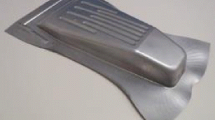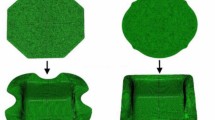Abstract
In deep drawing process, the blank holder plays a key role in adjustment of metal flow into the die cavity. Moreover, the quality of drawn parts is extremely affected by this flow. There are two methods of treating the blank holder in deep drawing and its simulation. One is blank holder force (BHF) and the other is blank holder gap (BHG), defined as the fixed distance between the blank holder and the die surface. In previous studies, a large number of experimental techniques have been used to study BHF; however, the amount of theoretical and numerical simulation work to study BHG is insufficient. In the present study, the concept of BHG profile, i.e., variation of BHG over punch stroke is introduced and it is shown that a properly selected BHG profile can improve the section thickness of formed part and result in the drawing of deeper parts. Here, two methods for the optimization of BHG profile are devised, i.e., the local optimization and the global optimization methods. In the first approach, the best BHG in each punch step is determined and finally, the local optimized BHG profile is achieved. In the second method, however, the empirical model for the prediction of final minimum section thickness in terms of BHG profile is obtained using design of experiments and neural networks. In the next stage, the proposed model is implanted into a simulated annealing optimization procedure to identify a proper BHG profile that can produce the desired blank thickness. Afterward, the BHG profile approach is applied to a variety of initial thicknesses, blank diameters, and materials in order to examine the robustness of method. In this paper, ABAQUS finite element package is used to gather finite element (FE) data and several experiments are performed to verify the FE results.
Similar content being viewed by others
References
Cao J, Boyce MC (1997) A predictive tool for delaying wrinkling and tearing failures in sheet metal forming. ASME J Eng Mater Technol 119:354–365
Yagami T, Manabe K, Yamauchi Y (2007) Effect of alternating blank-holder motion of drawing. J Mater Process Technol 188:187–191
Sheng ZQ, Jirathearanat S, Altan T (2004) Adaptive FEM simulation for prediction of variable blank-holder force. Int J Mach Tools Manuf 44:487–494
Chen L, Yang JC, Zhang LW, Yuan SY (2007) Finite element simulation and model optimization of blank-holder gap and shell element type in the stamping of a washing-trough. J Mater Process Technol 182:637–643
Huaibao W, Weili X, Zhongquin L, Yuying Y, Wang ZR (2002) Stamping and stamping simulation with a blank-holder gap. J Mater Process Technol 120:62–67
Thomas W (1999) Product tool and process design methodology for deep drawing and stamping of sheet metal parts. Dissertation, Ohio State University
Sibel E, Beisswanger H (1995) Deep drawing process. Carl Hanser, Munich
Siegert K, Dannenmann E, Galeikoet A (1995) Closed loop control system for lank-holder forces in deep drawing. Ann CIRP 44(1):251–254
Cao J, Boyce MC (1994) Design and control of forming parameters using finite element analysis. Symposium on Computational Material Modeling, Chicago
Gavas M, Izciler M (2007) Effect of blank-holder gap on deep drawing of square cups. Mater Des 28:1641–1646
Sing KS, Kumar RD (2004) Application of a neural network to predict thickness strains and finite element simulation of hydro-mechanical deep drawing. Int J Adv Manuf Technol 25:101–107
Cao J, Kinsey B, Solla SA (2000) Consistent and minimal springback using a stepped binder force trajectory and neural network. J Eng Mater-T ASME 122:113–118
Satoshi K, Kenta K, Koetsu Y (2011) Optimization of variable blank-holder force trajectory by sequential approximate optimization with RBF network. Int J Adv Manuf Technol 61:1067–1083
Chamekh A, BenRhaiem S, Khaterchi H, BelHadjSalah H, Hambli R (2010) An optimization strategy based on a meta-model applied for the prediction of initial blank shape in a deep drawing process. Int J Adv Manuf Technol 50:93–100
Kawaka M, Olejnik L, Rosochowski A, Sunaga H, Makinouchi A (2001) Simulation of wrinkling in sheet metal forming. J Mater Process Technol 109:283–289
ABAQUS finite element package 6.10.1
ABAQUS user’s manual
MATLAB user’s manual
Ozel T, Karpat Y (2005) Predictive modeling of surface roughness and tool wear in hard turning using regression and neural networks. Int J Mach Tools Manuf 45:467–479
Tae JK, Kim HS (1998) Autonomous cutting parameter regulation using adaptive modeling and genetic algorithms. Precis Eng 22(4):243–251
Kolahan F, Khajavi H (2010) A statistical approach for predicting and optimizing depth of cut in AWJ machining for 6063-T6 Al alloy. Int J Mech Syst Sci Eng 5(2):143–146
Venkataraman P (2002) Applied optimization with MATLAB programming. Wiley, New York
Laarhoven PJ, Aarts EL (1987) Simulated annealing theory and applications. Kluwer, London
Author information
Authors and Affiliations
Corresponding author
Rights and permissions
About this article
Cite this article
Hosseini, A., Kadkhodayan, M. A hybrid NN-FE approach to adjust blank holder gap over punch stroke in deep drawing process. Int J Adv Manuf Technol 71, 337–355 (2014). https://doi.org/10.1007/s00170-013-5479-7
Received:
Accepted:
Published:
Issue Date:
DOI: https://doi.org/10.1007/s00170-013-5479-7




